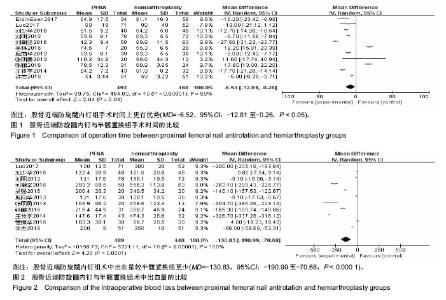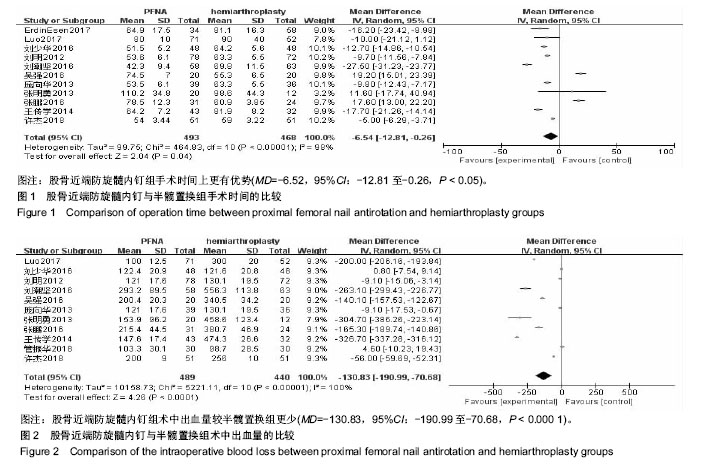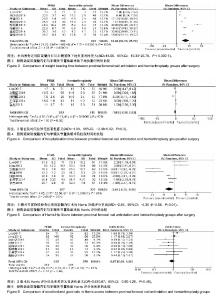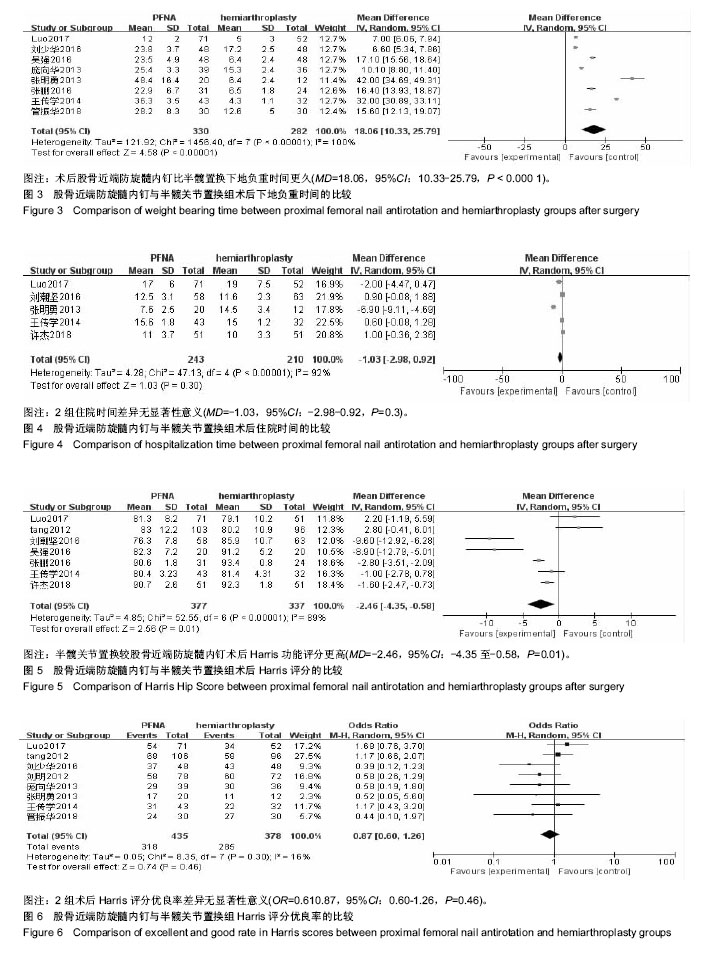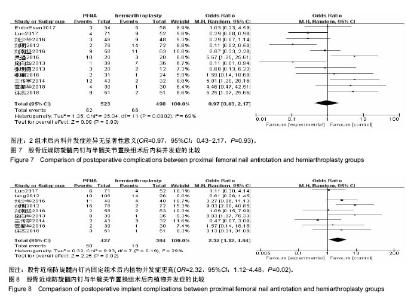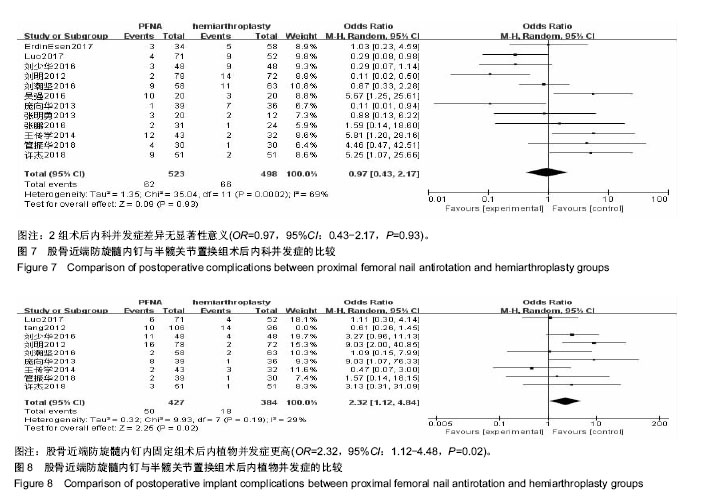| [1] Choi HJ,Kim E,Shin YJ,et al.The timing of surgery and mortality in elderly hip fractures:a retrospective ,multicenteric cohort study.Indian J Orthop. 2014;48(6):599-604. [2] Park-Wyllie LY,Mamdani MM,Juurlink DN,et al. Bi-sphosphonate use and risk of subtrochanteric or femoral shaft fractures in older wormen. JAMA. 2011;305(8):783-789.[3] Jadad AR, Moore RA, Carroll D, et al.Assessing the quality of reports of randomized clinical trials:is blinding necessary? Control Clin Trials. 1996;17(1):1-12.[4] 刘潮坚,蔡拉加,石昭宏,等.半髋置换与股骨近端防旋髓内钉治疗高龄不稳定股骨转子间骨折疗效比较[J].实用骨科杂志,2016, 22(6):556-558.[5] 吴强.骨水泥半髋关节置换与股骨近端防旋髓内钉 固定治疗高龄股骨转子间骨折疗效对比[J].医学信息, 2016,29(18): 176-177.[6] 张明勇,郭卫春,胡锐,等.人工半髋置换和股骨近端防旋髓内钉治疗高龄股骨转子间骨折[J]. 实用骨科杂志, 2013,19(5): 453-455.[7] 张鹏,杨波,秦之威,等.人工股骨头置换与 股骨近端防旋髓内钉-Ⅱ、锁定钢板内固定治疗高龄不稳定性股骨转子间骨折疗效分析[J]. 中华临床医师杂志(电子版), 2016,10(9):52-55.[8] 王传学,杜秀藩. 双极人工股骨头与股骨近端防旋髓内钉在不稳定型股骨粗隆间骨折的疗效评析[J].中华关节外科杂志(电子版), 2014,8(4):60-63.[9] 刘少华,周观明,卢绍椠,等.半髋关节置换与防旋型股骨近端髓内钉治疗96例高龄不稳定型股骨粗隆间骨折的疗效对比[J].吉林医学,2016,37(6):1377-1378.[10] 庞向华,欧兆强,欧阳建江.半髋关节置换与防旋型股骨近端髓内钉治疗高龄不稳定型股骨粗隆间骨折的疗效对比[J].重庆医学, 2013,42(10):1086-1088.[11] 许杰,张知博,姜永冲,等.加长柄股骨头置换与股骨近端防旋髓内钉II内固定治疗高龄不稳定型股骨转子间骨折疗效比较[J].生物骨科材料与临床研究,2018,15(2):73-74.[12] 管振华,彭观荣,饶文群, 等.重建股骨矩加长柄双动头半髋关节置换与股骨近端防旋髓内钉治疗高龄股骨粗隆间不稳定骨折探论[J].江西医药,2018,53(3):235-238.[13] 刘明,祝应平,郑松,等.半髋关节置换与股骨近端防旋髓内钉治疗高龄不稳定型股骨粗隆问骨折的临床疗效比较[J].中国现代医生,2012,50(36):156-158.[14] Tang P, Hu F, Shen J, et al. Proximal femoral nail antirotation versus hemiarthroplasty: a study for the treatment of intertrochanteric fractures. Injury. 2012;43(6):876-881.[15] Luo X, He S, Zeng D, et al. Proximal femoral nail antirotation versus hemiarthroplasty in the treatment of senile intertrochanteric fractures: Case Report. Int J Surg Case Rep.2017;38:37-42.[16] Esen E, Dur H, Atao?lu MB, et al. Evaluation of proximal femoral nail-antirotation and cemented, bipolar hemiarthroplasty with calcar replacement in treatment of intertrochanteric femoral fractures in terms of mortality and morbidity ratios. Eklem Hastalik Cerrahisi.2017; 28(1):35-40.[17] Haleem S, Lutchman L, Mayahi R ,et al .Mortality following hip fracture: trends and geographical variations over the last 40 years.Injury. 2008;39(10):1157-1163.[18] 陈孝平.外科学(七年制)[M].北京:人民卫生出版社, 2005: 958-960.[19] 郭震,姚勐炜,杨安礼,等.防旋型股骨近端髓内钉与Gamma钉治疗老年股骨转子间骨折的疗效观察[J].临床骨科杂志, 2011, 14(3):293-295.[20] 梁吉华,史源欣,邵伟忠,等.股骨近端防旋髓内钉与动力髋螺钉治疗股骨转子间骨折的疗效比较[J].中华创伤骨科杂志, 2011, 13(9):888-890.[21] 唐佩福,姚琦,黄鹏,等.股骨近端髓内钉-螺旋刀片治疗高龄骨质疏松性股骨转子间骨折[J].中华创伤骨科杂志, 2007,9(7): 622-624.[22] 易善钧,潘有春,李廷林,等.特制股骨假体置换治疗老年股骨粗隆部不稳定骨折[J].中国矫形外科杂志,2014,12(21):1651-1653.[23] 宋继淳,韩城龙,岑怡彪等.半髋关节置换与股骨近端防旋髓内钉在治疗不稳定型股骨粗隆间骨折的临床分析[J].临床医学工程, 2012,19(8):1276-1278. |
